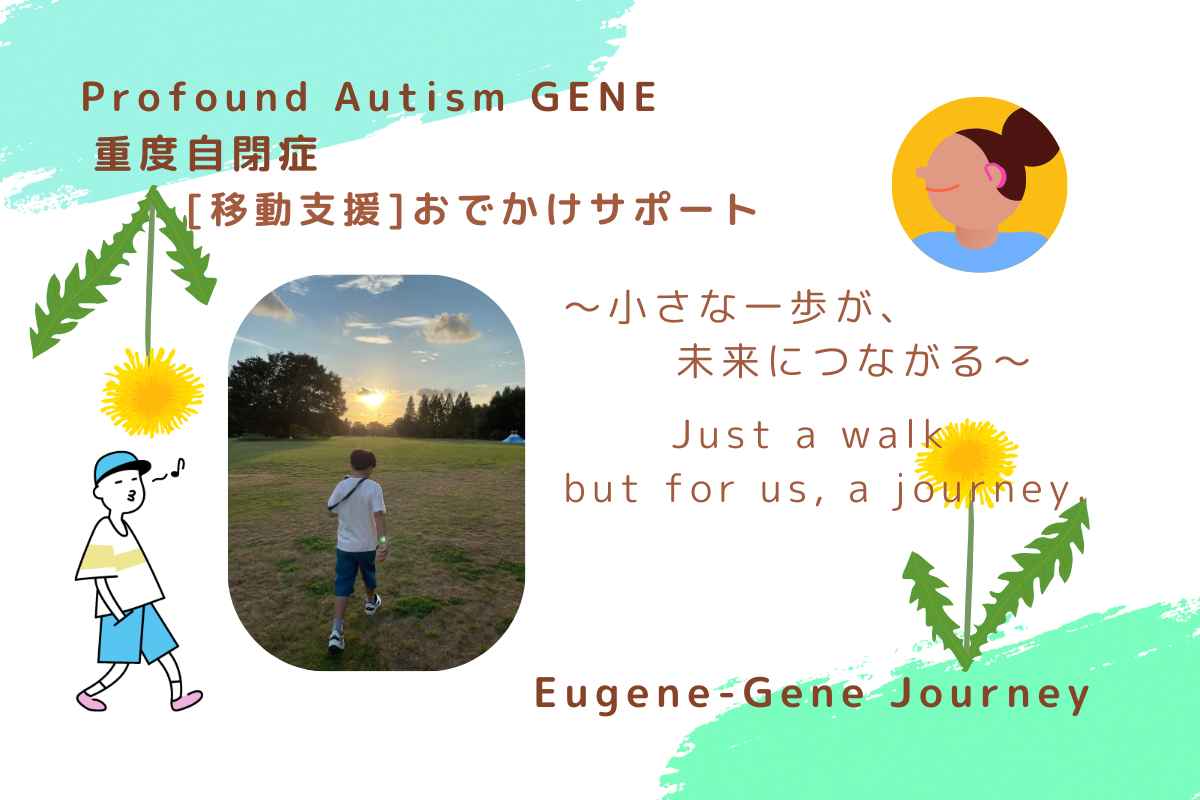―※English version below – sending love across the ocean.
この下に英語版もあります。海の向こうの誰かにも、届きますように。
移動支援を使おうと思ったきっかけ
重度自閉症の息子GENEと似たタイプの子どもたちが、移動支援を使ってお出かけを楽しんでいる様子を、あるブログで知りました。 私自身、毎回ヒヤヒヤしながら連れ出していたGENE。私ではコントロールできなくなりつつある彼に、でも家に閉じこもるだけではストレスがたまる。そんなジレンマの中、”誰かが連れて行ってくれる”という選択肢に希望を感じました。
近所の公園に行くことすら一大事。小さな子どもたちがいる中で、GENEが順番を守ったり、押さずに遊ぶことはまだ難しい。私も同じ大きさになったGENEを完全に抑える自信はなくなっていました。
だからこそ、いろいろな人と触れ合いながら、安心してお出かけできるように——そんな思いで、移動支援を使うことを決めました。
移動支援事業所を探すまでの道のり
移動支援の制度は自治体によって大きく異なります。同じように見えて、利用条件や支援内容はまちまち。
だからこそ、諦めずに情報を集めることが大切でした。私が相談したのは、
- 学校の先生(具体的な事業所名まで聞き出す)
- 放課後デイのスタッフさん
- 相談員の方(いちばん情報を持っている)
- ママ友
相談員の方の紹介で、ある大きな事業所に出会うことができました。
初めての事業所との面談
事業所の担当者と相談員さんと、我が家で面談。 (※相談員さんとの面談は基本的に自宅。家の様子確認も含まれると感じていますが、それもサポートにつながる大切な機会だと思っています)
その事業所は、特別支援学校の元先生が立ち上げた、支援に熱い想いを持った場所でした。
- 卒業後も生徒たちが困らないよう、必要なスキルを育てる支援
- ショートステイでは身支度を自分でできるようサポート
- 移動支援では、公共交通機関利用、食事や入館料の自己負担あり
スタッフさんも感じが良く、しっかりした印象。ただし、実際に担当してくれる人はまた別の方でした。
初めてのお散歩チャレンジ
実際に担当してくれたのは、若い男性スタッフさん。
最初の印象は——GENE、激怒。 家に知らない人が入ってきたことが嫌だったのか、怒りは私にも向かいました。
それでもなんとか3人で近所を散歩。GENEは散歩自体は楽しみたそう。でもスタッフさんには敵意むき出し。途中、木に登ろうとしたり、川に入ろうとしたり、道路に飛び出しそうになったり。
スタッフさんはGENEタイプへの対応に慣れていない印象でした。 「本当に移動支援ってこういうものなんだ」と実感した日でした。
行動援護という選択肢
GENEには、移動支援よりも「行動援護」という制度が適しているとわかりました。
行動援護とは、行動に著しい困難がある人に対して、移動の支援だけでなく、危険回避のサポートまでを行う制度。 ただし、行動援護は利用できる事業所が非常に少ない。狭き門です。
それでも、相談員さんが粘り強く探してくれました。
奇跡の出会い
そして、奇跡のようなご縁が。 GENEが通う放課後デイサービスの系列に、行動援護・移動支援を行っているスタッフさんがいたのです。 しかも、GENEが大好きなスタッフさん!
相談員さんとデイのスタッフさんのおかげで、その方が特別に移動支援を引き受けてくれることになりました。
こうして、GENEと、大好きなスタッフさんとのお出かけが始まったのです。
まとめ
移動支援は、ただ探すだけではなかなか見つからない。
でも、諦めずに動けば、想像もしなかったご縁がつながることもある。
GENEと私の一歩一歩は、まだまだ小さいかもしれない。 けれど、小さな一歩を積み重ねていくことが、未来につながる——そんな希望を、改めて感じた体験でした。
📌 「ウェルネット名古屋」
Visit: Wel Net Nagoya
Outing Support for Profound Autism: Our First Steps with Gene
Who This Post Is For
Parents raising children with profound autism who are considering using outing support services (formerly called “mobility support” in earlier drafts), or wondering how to even begin the process.
Why I Wanted to Try Outing Support
I used to read blogs written by other parents of children like Gene. One thing caught my eye—some kids were going on outings with trained support workers. And they looked so happy.
Could someone else take Gene out, just for a short walk? Someone trained and trustworthy?
Gene was becoming harder for me to manage outside. But staying home all day wasn’t the answer either. I thought even a walk to the local park might help release his stress. But for us, that short walk is a major challenge.
Why Even a Park Is a Big Deal
The park sounds easy, right? But it’s not.
Small kids are everywhere—toddlers, babies just starting to walk. Gene doesn’t yet understand how to wait or take turns. He might cut ahead in line or push slower kids on a climbing structure. I stay behind him like a shadow. I can follow him in, sure. But could I really stop him if something serious happened?
He doesn’t mean harm, but his size and lack of understanding make him unpredictable. When Gene was younger, it felt safer. He could keep up with older kids. But now he’s big—and still struggles with rules.
My long-term wish is for him to go out with different people and enjoy life. So, I started looking.
The Process: How We Found a Service Provider
I learned that outing support services differ a lot depending on where you live in Japan. Some municipalities offer more options than others.
But the key lesson? Don’t give up.
I started asking:
- Gene’s school teachers: “Do any students use outing support?”
- Daycare staff: “Do you know any providers?”
- Fellow parents: “Can you share info?”
- Most importantly, our welfare caseworker (相談員): She knew the full system.
She introduced me to a large, reputable organization. The founder was a former special-ed teacher. The organization’s focus was life skills for kids after graduation.
Their short-stay care emphasized independence. Their staff sounded great. We scheduled a home visit.
The Home Interview: Nerve-Wracking but Hopeful
The caseworker and service rep came to our house. (Side note: these visits always make me nervous—are they checking if I’m coping? If the house is clean? If I’m “okay”? Probably just my imagination.)
But they were kind and clear. They explained the costs:
- We cover public transport.
- No private cars allowed.
- We also pay staff entry fees and meals if we go to paid venues.
A male staff member from the agency would be Gene’s match.
The First Trial: Gene, Me, and the New Staff
The first session? Disaster.
A new person stepped into our home. Gene flipped.
He got so upset he lashed out—at me. Still, the three of us went for a walk.
Gene wanted the walk, but not the staff. He told him to leave, angrily. But he walked.
He tried climbing a tree. Bolted toward the street. Jumped into a stream after ducks.
The staff was kind but inexperienced. He didn’t seem trained for Gene’s level.
I realized: outing support is not the same as behavioral support. This staff wasn’t the right fit—not yet.
I needed something more structured.
What About Behavioral Support (行動援護)?
Gene technically qualifies for “behavioral support.” But providers are limited. Websites might say they offer it, but once you call, they’re full.
Still, our caseworker tried hard.
The Lucky Break: Finding the Right Person
Here’s the twist: Gene’s afterschool daycare also offered outing support—but very quietly. One staff member there had the correct license and agreed to take on Gene.
Why? Because he already knew Gene. And he liked him.
That made all the difference.
He became Gene’s companion. And that’s how our journey began.
A Final Thought
Outing support isn’t just about getting out of the house. It’s about learning to trust others. It’s about creating future options.
We’re still early in our journey. But every step forward—no matter how small—feels like a big win.
Let’s keep walking.
📌 Want to know more about Japan’s systems?
Visit: Wel Net Nagoya


